Braces treatment, while essential for achieving a beautiful smile, can occasionally lead to unexpected challenges. Whether it’s a broken bracket, a poking wire, or discomfort from your braces, knowing how to prevent orthodontic emergencies can make your treatment more comfortable and less stressful. By following a few simple guidelines, you can keep your braces in top condition, avoid major issues, and ensure a smooth journey to a perfect smile.
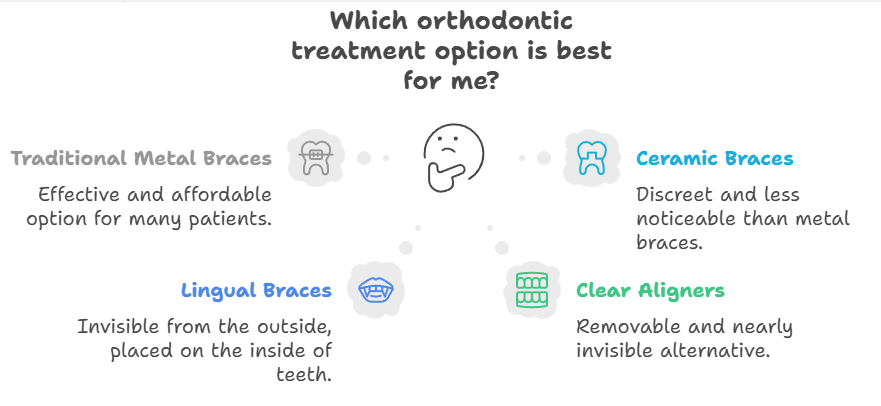
Understanding Orthodontic Treatment
Orthodontic services are a specialized branch of dentistry provided by orthodontists, who focus on diagnosing, preventing, and treating dental and facial irregularities. The primary goal is to improve the alignment and positioning of teeth, enhancing both the health and function of your mouth.
There are several types of orthodontic treatments available, each with its own set of benefits and drawbacks. Traditional metal braces are a common choice due to their effectiveness and affordability. Ceramic braces offer a more discreet option as they are tooth-colored and less noticeable. Lingual braces are placed on the inside of the teeth, making them invisible from the outside. Clear aligners, such as Invisalign, provide a removable and nearly invisible alternative. The best option for you will depend on your specific needs and preferences. Additionally, braces cost can vary significantly based on factors like type, complexity, and treatment duration.
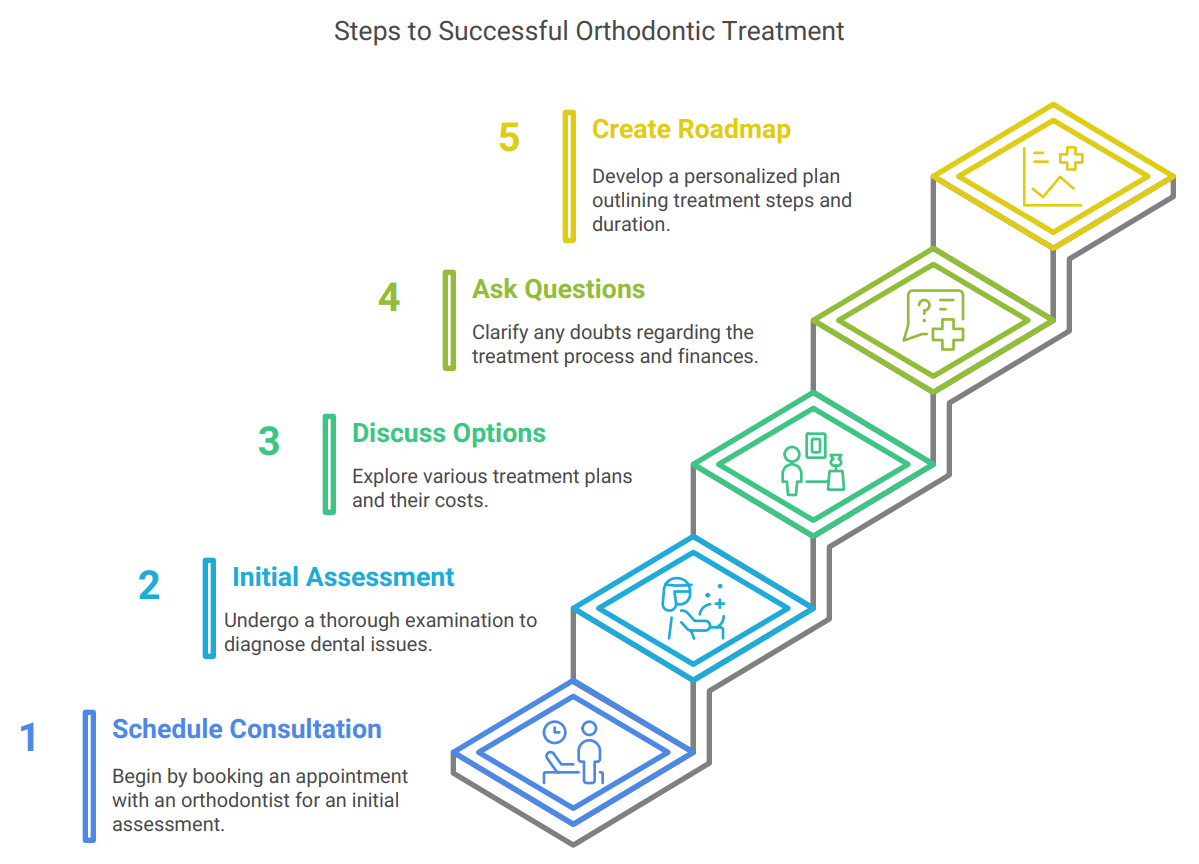
Benefits of Early Orthodontic Treatment
Early orthodontic treatment can have a significant impact on a child’s oral health and development. By addressing orthodontic issues early, children can avoid more severe problems later on, such as crooked teeth, crowded teeth, and bite problems. Early treatment can also help to:
Improve the alignment of teeth and jaws
Enhance the overall appearance of the smile
Boost self-confidence and self-esteem
Reduce the risk of tooth decay and gum disease
Improve oral health and dental health
The American Association of Orthodontists (AAO) recommends that children have their first orthodontic evaluation around age 7. This early evaluation can help to identify potential issues and provide a proactive approach to orthodontic treatment. By catching problems early, orthodontists can guide the growth and development of the jaw and teeth, making future treatments less complex and more effective.
Choosing the Right Types of Braces
Selecting the right orthodontic treatment can feel overwhelming with so many options available. It’s important to consider several factors, including the severity of your orthodontic issue, your age, overall health, and personal preferences.
Traditional metal braces are highly effective and often the most affordable option, but they are also the most visible. Ceramic braces, being tooth-colored, offer a more discreet alternative but can be more expensive. Lingual braces are completely hidden from view as they are attached to the back of the teeth, but they can be more costly and may not be suitable for severe cases. Clear aligners like Invisalign are popular for their removability and invisibility, though they may not be ideal for complex orthodontic issues and can be more expensive.
Discussing these options with your orthodontist will help you make an informed decision to best cater to your lifestyle and treatment goals.
Types of Dental Braces
There are several types of dental braces available, each with its own unique characteristics and benefits. Some of the most common types of braces include:
Traditional Metal Braces: These are the most common type of braces and are made of high-quality stainless steel. They are durable, effective, and affordable.
Ceramic Braces: These braces are made of tooth-colored ceramic material and are designed to be less noticeable than traditional metal braces.
Lingual Braces: These braces are placed on the back of the teeth, making them invisible from the front. They are a popular choice for adults and teens who want a discreet orthodontic solution.
Self-Ligating Braces: These braces use a special type of bracket that allows the wire to slide freely, reducing the need for adjustments and making treatment faster and more comfortable.
Clear Aligners: These are a type of removable orthodontic appliance that is designed to straighten teeth without the use of traditional braces.
Each type of braces has its own set of advantages, and the best choice depends on individual needs and preferences. Consulting with an orthodontist can help determine the most suitable option for achieving a new, healthy, beautiful smile.
How Traditional Braces Work
Traditional metal braces are a popular choice for orthodontic treatment because they are effective, durable, and affordable. Here’s how they work:
Brackets are attached to the teeth using a special type of cement.
A wire is threaded through the brackets and tightened to apply pressure to the teeth.
The wire is adjusted regularly to continue applying pressure and moving the teeth into their desired position.
The brackets and wire work together to apply constant pressure to the teeth, gradually moving them into alignment.
Treatment typically takes several months to several years, depending on the severity of the orthodontic issue.
Traditional metal braces are a reliable and effective way to straighten teeth and improve oral health. With proper care and maintenance, they can help to achieve a beautiful, healthy smile that lasts a lifetime. Regular visits to the orthodontist for adjustments and following their care instructions are essential for the success of the treatment.
Preparing for Orthodontic Treatment
Preparation is key to a successful orthodontic treatment journey. Start by scheduling a consultation with an orthodontist, who will conduct a thorough examination of your teeth and mouth. This initial assessment helps in diagnosing the specific issues and determining the best course of treatment.
During the consultation, the orthodontist will discuss various treatment options and their associated costs. Braces cost can vary significantly based on factors like type, complexity, and treatment duration. This is the perfect time to ask any questions you may have and to understand the financial aspects, including insurance coverage. Once you decide on a treatment plan, the orthodontist will create a personalized roadmap outlining the steps involved, the expected duration, and the overall cost of the treatment.
1. Understanding Orthodontic Emergencies
Before diving into the prevention tips, it’s important to understand what constitutes an orthodontic emergency. Emergencies typically refer to issues that cause discomfort, interrupt the progress of treatment, or lead to further complications if not addressed promptly. These may include:
Broken brackets
Poking wires
Lost or damaged rubber bands
Loose or missing spacers
Severe pain or discomfort due to improper adjustment
While not all issues require immediate action, knowing the difference between a minor inconvenience and an urgent emergency will help you address problems effectively.
2. Avoid Hard, Sticky, and Crunchy Foods
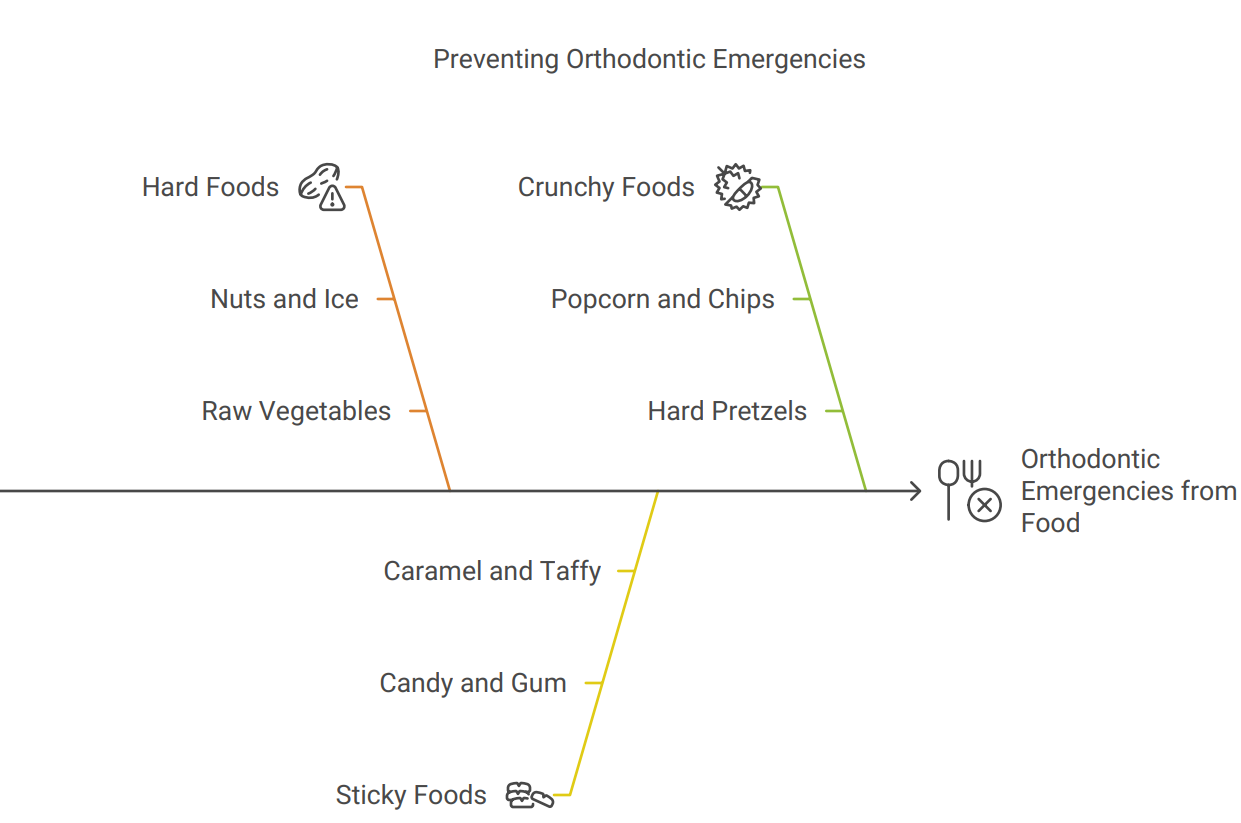
One of the biggest contributors to orthodontic emergencies is the type of food you eat. Certain foods can break, bend, or damage your braces, hindering your treatment. To prevent such problems, steer clear of:
Hard foods: Items like nuts, ice, hard candy, and raw vegetables (such as carrots and apples) can easily break off your brackets and wires.
Sticky foods: Candy, gum, caramel, taffy, and other chewy treats can get stuck in your braces and can pull off brackets, or cause food particles to accumulate around the braces, increasing the risk of decay.
Crunchy foods: Popcorn, chips, and hard pretzels may seem harmless, but they can still damage your braces by breaking brackets or dislodging wires.
3. Cut Food into Smaller Pieces
If you simply can’t resist certain foods, cut them into smaller, bite-sized pieces before eating. This allows you to avoid putting too much pressure on your braces. For example, instead of biting into an apple, cut it into small pieces. The same goes for pizza crusts, sandwiches, and other foods that may be hard to chew.
4. Be Careful with Biting Non-Food Items
Many people are guilty of using their teeth to open packages, bite nails, or hold onto objects like pens. However, using your teeth as tools can be incredibly damaging to your braces. Not only can you break a bracket or bend a wire, but you could also damage your teeth, which can delay your treatment or cause other health issues.
Always use scissors, a knife, or another appropriate tool to open packages or perform tasks. Avoid biting down on objects like pens or pencils, which can cause unnecessary strain on your teeth and braces.
Maintaining Proper Oral Hygiene with Fluoride Toothpaste
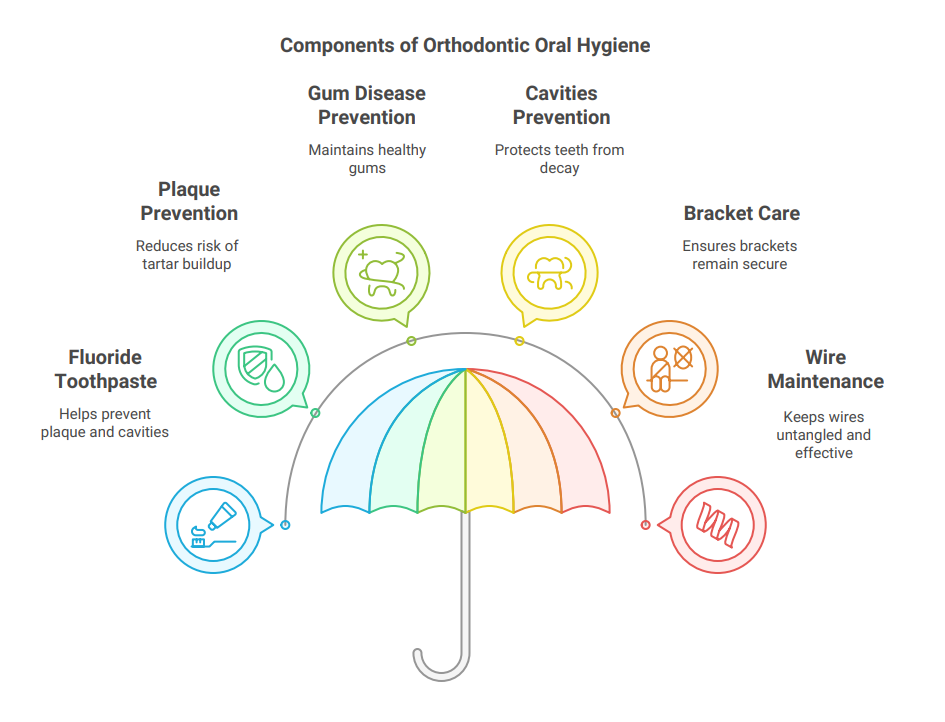
Proper oral hygiene is vital during orthodontic treatment. Maintaining oral hygiene while wearing braces is especially important due to the additional care needed for wires and brackets that can trap plaque and food debris. Using fluoride toothpaste can help prevent plaque and tartar buildup around braces, reducing the risk of cavities and gingivitis. Failing to clean your braces properly can lead to plaque buildup, gum disease, or cavities, all of which can complicate your treatment and cause discomfort. Inadequate brushing and flossing can also result in brackets becoming loose or wires becoming tangled.
Here’s what you should do:
Brush your teeth after every meal to remove food particles from around your braces.
Use a soft-bristled toothbrush to avoid damaging your braces and gums.
Floss daily with a floss threader to ensure you clean between your teeth and braces properly.
Use mouthwash to help reduce plaque buildup and maintain fresh breath.
1. Use an Interdental Brush
Sometimes regular brushing doesn’t remove all food particles from the tiny spaces between your braces and teeth. An interdental brush (or proxabrush) is an excellent tool for getting into those hard-to-reach spots. It helps remove plaque and debris from areas where your regular toothbrush may not reach, reducing the risk of damaging your braces or getting cavities.
2.Avoid Sugar-Rich Foods and Drinks
Sugary foods and drinks increase the risk of plaque buildup, which can lead to cavities and staining around your braces. Sticky candies, sugary snacks, sodas, and juices should be consumed sparingly. If you do have something sugary, make sure to brush your teeth soon afterward.
3.Wear a Mouth guard for Physical Activities
If you play contact sports or engage in rather physical activities, a mouth guard is essential to protect your braces, teeth, and gums. Accidents often happen during sports, and having a fitted mouth guard will provide an extra layer of protection.
Sports like basketball, football, soccer, and hockey carry a risk of injury, and braces can make your teeth more vulnerable to damage. A custom mouthguard designed for braces will ensure your teeth remain safe from impact.
4. Careful with Hard Chewing Gums
While sugar-free gum is often harmless, it’s best to avoid chewing gum altogether while you’re undergoing orthodontic treatment. Gum can get stuck in your braces, and excessive chewing can dislodge brackets or wires.
If you do chew gum, make sure it’s sugar-free and soft. Avoid hard or sticky types, as they can damage your braces and create more work for your orthodontist.
Monitor Your Braces Regularly
It’s essential to inspect your braces regularly, especially after eating or drinking. Check for any loose brackets, wires, or rubber bands. If you notice any components that aren’t functioning as they should, contact your orthodontist immediately. The sooner you address small issues, the less likely they are to turn into major problems.
Use Orthodontic Wax for Temporary Relief
Orthodontic wax is a lifesaver for many braces wearers. If a wire or bracket is causing irritation to the inside of your mouth, applying a small piece of orthodontic wax over the affected area can provide temporary relief. It will help protect your cheeks, gums, and lips from painful rubbing and irritation.
Keep orthodontic wax with you at all times, especially during the early stages of treatment when your mouth is adjusting to the new braces.
Attend Regular Appointments and Follow-Ups
Regular visits to your orthodontist are essential for those who wear braces to ensure that your treatment is progressing as planned. These visits allow your orthodontist to check your braces for any issues, tighten wires, replace rubber bands, and make adjustments. Consistent follow-up appointments are vital for staying on track and preventing orthodontic emergencies.
If you experience any discomfort or notice any damage to your braces between appointments, don’t wait for your next scheduled visit. Call your orthodontist for guidance or to arrange an earlier appointment if needed.
How to Deal with Loose Brackets
A loose bracket can be a potential emergency. If you feel that a bracket is becoming loose, avoid touching it too much. If it’s still attached to the wire but wobbly, you can try to use some orthodontic wax to keep it in place until you can see your orthodontist. If the bracket is completely detached, try to keep it safe and bring it to your next appointment.
In some cases, the orthodontist may need to reattach the bracket or adjust the wire to prevent further issues.
Manage Poking Wires
Poking wires are another common issue during orthodontic treatment. If a wire becomes too long or starts poking into the back of your mouth, it can cause pain and irritation. The best way to deal with this is to apply orthodontic wax over the sharp end of the wire. You can also use tweezers to gently bend the wire if you’re able to do so safely. However, if the wire is too long, it’s best to contact your orthodontist to schedule an adjustment.
Understand the Importance of Retainers
Once your braces come off, your orthodontist will likely recommend that you wear a retainer. Retainers are essential for keeping your teeth in their new position and preventing them from shifting back. Skipping or neglecting to wear your retainer can result in the need for additional orthodontic treatment down the road.
Be sure to follow your orthodontist’s instructions on when and how often to wear your retainer, and keep it clean to avoid any potential issues.
Be Mindful of Tooth Sensitivity
Many patients experience tooth sensitivity, especially after their braces are first placed or after an adjustment. If you feel discomfort or sensitivity, take pain relievers as recommended by your orthodontist. Rinsing with warm salt water can also help soothe irritation.
Avoid consuming very hot or cold foods and drinks until the discomfort subsides. If the sensitivity persists or worsens, contact your orthodontist for advice.
Don’t Skip Your Post-Braces Appointments
After your braces are removed, your orthodontist will schedule follow-up appointments to monitor the alignment of your teeth and ensure that the retainer is doing its job. These appointments are crucial for ensuring that your teeth remain in the correct position. Skipping them could result in relapse, where your teeth shift back into their original positions, requiring additional treatment.
Know When to Seek Help: Emergency vs. Non-Emergency
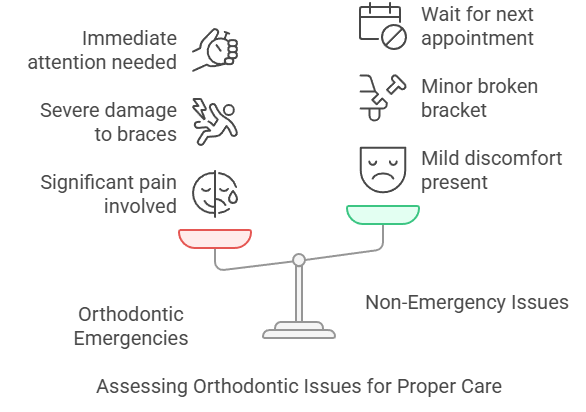
It’s essential to distinguish between an orthodontic emergency and a non-emergency issue to maintain overall dental health. Emergencies typically involve significant pain, severe damage to the braces, or risk to your oral health. Non-emergencies, such as mild discomfort or a minor broken bracket, can often be resolved with simple fixes or by waiting until your next appointment.
In any case, if you’re unsure whether something qualifies as an emergency, don’t hesitate to contact your orthodontist. They can guide you on whether you need immediate attention or if it’s safe to wait until your next scheduled visit.
Cost and Insurance
The cost of orthodontic treatment can vary significantly based on the type of treatment, the complexity of the case, and the location of the orthodontist. Traditional metal braces typically range from $3,000 to $7,000, while ceramic braces can cost between $4,000 and $8,000. The braces cost can also be influenced by the duration of the treatment and any additional procedures that may be required. Understanding these factors can help you better manage and plan for the financial aspect of getting braces.
Many insurance plans offer coverage for orthodontic treatment, particularly for children and adolescents. However, the extent of coverage can differ widely depending on the plan and the type of treatment. It’s crucial to discuss the cost and insurance details with your orthodontist before starting treatment. They can help you understand your options and may offer a personalized payment plan to fit your budget. Additionally, some orthodontists provide tips on how to save and manage costs associated with braces, making it easier to afford the necessary treatment.
Benefits of Traditional Metal Braces
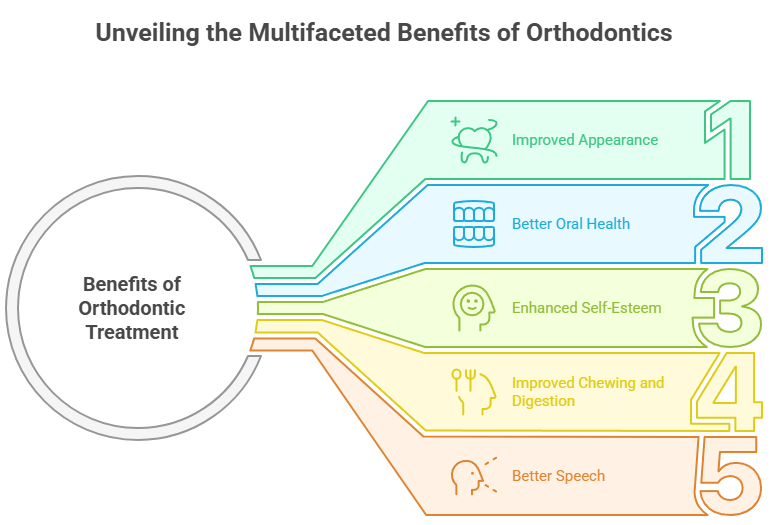
Orthodontic treatment offers numerous benefits that go beyond just a beautiful smile. Here are some of the key advantages:
Improved Appearance: Straightening teeth enhances your smile, boosting your confidence and self-esteem.
Better Oral Health: Properly aligned teeth are much easier to clean, in turn lowering the risk of gum disease and tooth decay.
Enhanced Self-Esteem: A beautiful smile can significantly improve your self-confidence, especially in social and professional settings.
Improved Chewing and Digestion: Correcting bite issues ensures that food is chewed properly, aiding in better digestion.
Better Speech: Addressing alignment issues can improve speech and pronunciation, particularly in cases of severe malocclusions.
Overall, orthodontic treatment can have a profound impact on your oral health, appearance, and quality of life, making it a worthwhile investment
